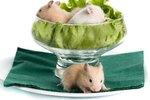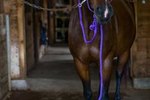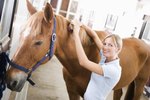
A horse’s teeth and mouth are large compared to his head. When relaxed, you may be able to see the bottom teeth, but in order to see the horse’s full set of teeth, the horse must move his top lip. This is a natural movement in some scenarios and the meaning of the movement depends on the context. The act of showing teeth can be passive or aggressive.
Symptoms of Colic
When a horse has colic, the horse may grind his teeth and curl up his top lip. Since the lip-curling is also a sign of sexual arousal, it is important to identify other symptoms, to ensure an accurate diagnosis. Other colic symptoms include lack of appetite, grunting, sweating and rapid breathing.
Flehmen Response
When a horse detects an unusual or interesting odor, for example, if a stallion gets the scent of a mare in heat, the horse will curl up his top lip in what is called the Flehmen response. This is the horse’s way of getting a better sniff of the scent and analyzing the pheromones in the scent, if it is a horse’s scent.. The lip-curling action resembles a smile and horse owners often train their animal to perform this action on command, typically by placing a strong or unusual smelling item under the horse’s nose, waiting for the lip-curl, then rewarding with food.
Relaxed Mouth
When a horse is relaxed, his bottom lip will droop, or sag. This is a sign of contentment in the horse. Only when he is alert or feeling stubborn will he tighten his lips. Combined with the position of his ears and general demeanor, you can tell a lot about a horse’s mood by observing his facial features.
Baring the Teeth
When a horse deliberately bares his teeth and there are no obvious olfactory stimuli, such as unusual smells, it is a sign of aggression or agitation. If the horse is startled, for example, or is being pestered by another animal, he may resort to showing his teeth as a warning. If he’s tossing his head around or attempting to run away, those bared teeth are almost certainly a sign that the horse is feeling defensive.
Various Vocalizations
Many horse vocalizations have the side effect of exposing the teeth. Neighing, for example, requires the horse to open his mouth wide, in order to let the sound resonate. As he does this, you’ll see a flash of his teeth. But it is the sound, rather than the sight of his teeth, that carry the meaning here. Neighing is typically a sign of excitement or anxiety. Observe the horse’s general demeanor and body language to determine between the two. Blowing, where the horse inhales and lets out a long breath while allowing the lips to flap against one another, also exposes the teeth.
References
Photo Credits
-
Digital Vision./Digital Vision/Getty Images
Writer Bio
Simon Foden has been a freelance writer and editor since 1999. He began his writing career after graduating with a Bachelors of Arts degree in music from Salford University. He has contributed to and written for various magazines including "K9 Magazine" and "Pet Friendly Magazine." He has also written for Dogmagazine.net.



